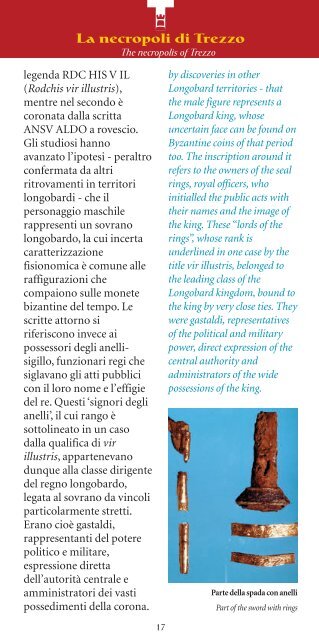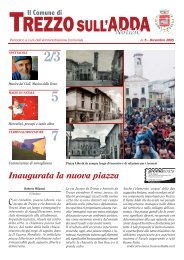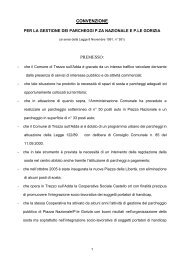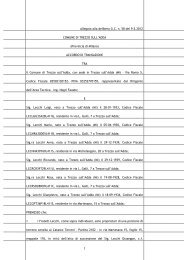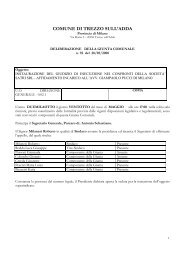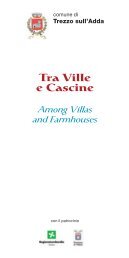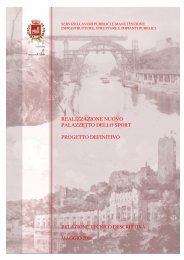I longobardi a Trezzo - Comune di Trezzo sull'Adda
I longobardi a Trezzo - Comune di Trezzo sull'Adda
I longobardi a Trezzo - Comune di Trezzo sull'Adda
Create successful ePaper yourself
Turn your PDF publications into a flip-book with our unique Google optimized e-Paper software.
T<br />
La necropoli <strong>di</strong> <strong>Trezzo</strong><br />
The necropolis of <strong>Trezzo</strong><br />
legenda RDC HIS V IL<br />
(Rodchis vir illustris),<br />
mentre nel secondo è<br />
coronata dalla scritta<br />
ANSV ALDO a rovescio.<br />
Gli stu<strong>di</strong>osi hanno<br />
avanzato l’ipotesi - peraltro<br />
confermata da altri<br />
ritrovamenti in territori<br />
<strong>longobar<strong>di</strong></strong> - che il<br />
personaggio maschile<br />
rappresenti un sovrano<br />
longobardo, la cui incerta<br />
caratterizzazione<br />
fisionomica è comune alle<br />
raffigurazioni che<br />
compaiono sulle monete<br />
bizantine del tempo. Le<br />
scritte attorno si<br />
riferiscono invece ai<br />
possessori degli anellisigillo,<br />
funzionari regi che<br />
siglavano gli atti pubblici<br />
con il loro nome e l’effigie<br />
del re. Questi ‘signori degli<br />
anelli’, il cui rango è<br />
sottolineato in un caso<br />
dalla qualifica <strong>di</strong> vir<br />
illustris,appartenevano<br />
dunque alla classe <strong>di</strong>rigente<br />
del regno longobardo,<br />
legata al sovrano da vincoli<br />
particolarmente stretti.<br />
Erano cioè gastal<strong>di</strong>,<br />
rappresentanti del potere<br />
politico e militare,<br />
espressione <strong>di</strong>retta<br />
dell’autorità centrale e<br />
amministratori dei vasti<br />
posse<strong>di</strong>menti della corona.<br />
17<br />
by <strong>di</strong>scoveries in other<br />
Longobard territories - that<br />
the male figure represents a<br />
Longobard king, whose<br />
uncertain face can be found on<br />
Byzantine coins of that period<br />
too. The inscription around it<br />
refers to the owners of the seal<br />
rings, royal officers, who<br />
initialled the public acts with<br />
their names and the image of<br />
the king. These “lords of the<br />
rings”, whose rank is<br />
underlined in one case by the<br />
title vir illustris, belonged to<br />
the lea<strong>di</strong>ng class of the<br />
Longobard kingdom, bound to<br />
the king by very close ties. They<br />
were gastal<strong>di</strong>, representatives<br />
of the political and military<br />
power, <strong>di</strong>rect expression of the<br />
central authority and<br />
administrators of the wide<br />
possessions of the king.<br />
Parte della spada con anelli<br />
Part of the sword with rings


